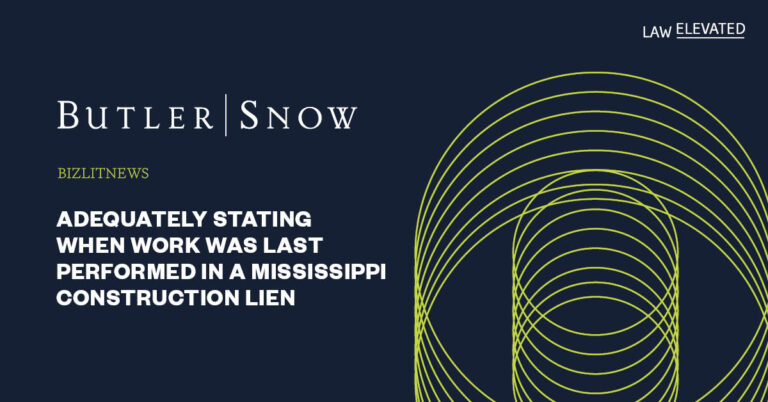Every state has a deadline by which construction liens must be filed, although states have different triggering events. In Mississippi, lien deadlines are based off when work was last performed, or labor, services, or materials were provided. See Miss. Code Ann. § 85-7-405(1)(b). A lien is supposed to state “in substance” when the claim “became due.” Id. And parenthetical remarks to the statutory form lien language say that a lien should “specify the date the claim was due, which is the same as the last date the labor, services or materials were supplied to the premises.” Id. A recent opinion from the United States District Court for the Southern District of Mississippi provides insight into when this standard is (and is not) met. See Cuevas Mach. Co., Inc. v. Calgon Carbon Corp., No. 1:24-CV-114-HSO-BWR, 2025 WL 1135035, at *6 (S.D. Miss. Mar. 20, 2025).
The lien in Cuevas did not state the last date work was performed, but invoices were attached to the lien. The lien claimant argued that the attached invoices satisfied “in substance” the requirement to specify the last date work was performed. Without deciding whether an attached invoice, alone, could satisfy the statutory requirement to specify when work was last performed, the District Court found the lien to be invalid because “the Court—and presumably the Defendant—cannot say with certainty exactly what the dates on the attached invoices represent.” Id.
The Cuevas court also denied the lien claimant’s request to hold an evidentiary hearing to determine when the claim became due. Liens are creatures of statute and are, therefore, strictly construed. Moreover, a provision in Mississippi’s construction lien statute specifically says “[t]he failure to specify both the amount claimed due under the lien and the date the claim was due shall result in the lien not constituting notice for any purposes.” Miss. Code Ann. § 85-7-415(3). And another provision requires that “[t]o make good a [special lien on real estate], it must be created and declared in accordance with the following provisions, and on failure of any of them the lien shall not be effective or enforceable[.]” Miss. Code Ann. § 85-7-405(1). Thus, the court concluded that “regardless of what such a hearing might reveal about the date the claim became due, the simple fact would remain that at the outset Cuevas did not comply with the requirements of Miss. Code Ann. § 85-7-405 by specifying a date in the Liens (or their attachments).” Cuevas, 2025 WL 1135035, at *7. Thus, the court declined to conduct an evidentiary hearing.
Although the Cuevas opinion is on appeal to the Fifth Circuit, it provides helpful insight into how a court may interpret Mississippi’s lien statutes. A key takeaway is that lien should clearly and expressly state when the claim became due or when work was last performed. Ideally this would be done on the face of the lien itself. But if not, this date should be apparent from any attachments, such as invoices or applications for payment.
One issue the Cuevas court did not address is potential ambiguity in the statutory language. Miss. Code Ann. § 85-7-405(1)(b) says that a lien must be filed “within ninety (90) days after the claimant’s last work performed, labor, services or materials provided, the furnishing of architectural services, or the furnishing or performing of surveying or engineering services.” But the form lien language included in that same subsection says to specify the date the claim “became due on.” Id. And parenthetical comments suggest that the date the claim became due “is the same as the last date the labor, services or materials were supplied to the premises.” Id. This will not always be the case.
For example, under many standard contractual arrangements, there is a deadline to submit a payment application for work already performed and then payment is due at some predetermined time thereafter. Thus, the date payment is due may not be the same date work was last performed or labor, material, or services were provided. Since statutory lien requirements are strictly construed, the safer practice is to determine the actual day work was last performed or labor, services, or material were provided, rather than rely on the date of an invoice or application for payment.
